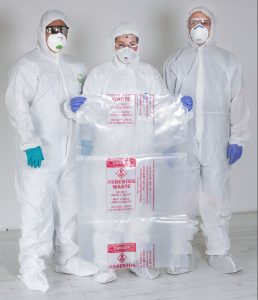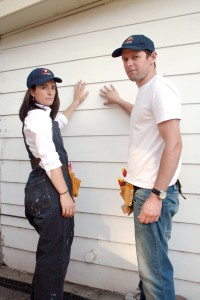Important Safety Facts To Know When Working With Asbestos
- PROTECTION: There are a number of safety precautions you will need to take including wearing approved PPE and RPE such as protective clothing, the correct mask (not every mask is safe) or breathing apparatus.
- REMOVAL:
- To learn more information about working safely with asbestos read Safe Work Australia’s Model Code of Practice: How to safely remove asbestos July 2020.
- Asbestos – A guide for householders and the general public.
- To learn about specific council regulations contact your local council
- DISPOSAL: To locate your closest asbestos disposal facility visit the Asbestos Safety & Eradication Agency’s disposal database
- REMEMBER: If the asbestos is in powder form or can be crumbled, pulverised or reduced to powder by hand pressure when dry (don’t try this), it MUST be removed by an asbestos removal contractor with a friable asbestos licence – Class A.
Find Out More About Managing Asbestos Safely
Multiple Fact Sheets and downloadable resources have been developed for homeowners, tradies, farmers and commercial properties on how to manage asbestos in the their homes and workplaces safely including:
- FS1: Fact Sheet 1 Working Safely With Asbestos Around The Home
- FS2: Fact Sheet 2Safe practices for homeowners repairing or removing small amounts of asbestos materials Provides instructions on the equipment you will need and the instructions on how to manage the process safely.
- FS3: Fact Sheet 3 Rural, Regional & Farming
- FS4: Fact Sheet 4 PPE & RPE
- T2: A Tradie’s Guide To Safe Practices In Managing Asbestos In Residential Properties
- Asbestos Management Handbook For Commercial & Non-Residential Properties
- Naturally Occurring Asbestos Guide
The 20 Point Asbestos Safety Check
- At least 1 in 3 Australian homes contain asbestos including brick, weatherboard, fibro and clad homes and apartments.
- Asbestos was widely used in the manufacture of building materials and other products prior to being phased out by 1990 and banned in 2003. Therefore:
- If your home was built or renovated prior to 1987 it is ‘highly likely’ that it contains products incorporating asbestos.
- If your home was built or renovated between 1987 and 1990 it is ‘likely’ that it may contain some asbestos-containing materials.
- However, if your home was built or renovated after 1990 it is ‘unlikely’ that asbestos-containing materials will be present.
- If asbestos is disturbed during renovations or maintenance your health and the health of your family could be at risk.
- DIY is not recommended where asbestos is present.
- When renovating or working in and around homes, if in doubt assume asbestos materials are present and take every precaution.
- Dealing with asbestos is important and serious, but it’s not overwhelming – IT IS MANAGEABLE!
- If you’re not sure if asbestos is in your home you can have it inspected by a licenced removalist or a licensed asbestos assessor.
- Products made from asbestos cement include fibro sheeting (flat and corrugated), water, drainage and flue pipes, roofing shingles, guttering and floor and wall coverings. It could be anywhere! Visit the Asbestos Products Database to find out more.
- If you find asbestos in your home; Don’t cut it! Don’t drill it! Don’t drop it! Don’t sand it! Don’t saw it! Don’t scrape it! Don’t scrub it! Don’t dismantle it! Don’t tip it! Don’t waterblast it! Don’t demolish it! And whatever you do… Don’t dump it!”
- If left undisturbed asbestos materials in good, stable condition are unlikely to release dangerous fibres and pose a health risk. Generally, you don’t need to remove the asbestos. Paint it and leave it alone but remember to check it occasionally for any signs of wear and tear.
- There are legal requirements regarding asbestos management, its removal and disposal.
- While some might follow the regulations and safety requirements to remove small amounts of asbestos, the safest way to manage its removal is to retain a licenced professional asbestos removalist equipped to protect you and your family from the dangers of asbestos dust and fibres.
- Where asbestos fibres are friable (loose and not bonded into building materials), ONLY licenced friable asbestos removalists are allowed to remove it.
- Professional removal of asbestos is affordable. You can’t afford not to use a professional!
- The cost of asbestos removal by a licenced professional is comparable to most licenced tradesmen including electricians, plumbers and tilers.
- The cost of disposal at a lawful site is often included with the cost of removal by a licenced professional.
- If you must work with any material that may contain asbestos or remove asbestos yourself, protect yourself and your family and follow the legal and safety requirements for the management of asbestos to minimise the release of dust or small particles from the asbestos materials.
- There are a number of safety precautions you will need to take including wearing specific protective clothing, the correct mask or breathing apparatus and ensure you minimise dust and dispose of it legally. Download Fact Sheet 1 or 2 for instructions on how to do this.
- Never use tools on asbestos materials as they will make asbestos fibres airborne including: Power tools such as electric drills, angle grinders, circular saws and electric sanders. Never use high pressure water blasters or compressed air.
- Don’t play renovation roulette! Think Smart. Think Safe. Think asbestosawareness.com.au – Because it’s not worth the risk!
For details about the regulations in your state visit
- Australian Capital Territory – Asbestos Taskforce ACT
- New South Wales – Asbestos NSW
- Northern Territory – Asbestos NT
- Queensland – Asbestos Queensland
- South Australia – Asbestos South Australia
- Tasmania – Asbestos Tasmania
- Victoria – Asbestos Victoria
- Western Australia
Share this information on:


